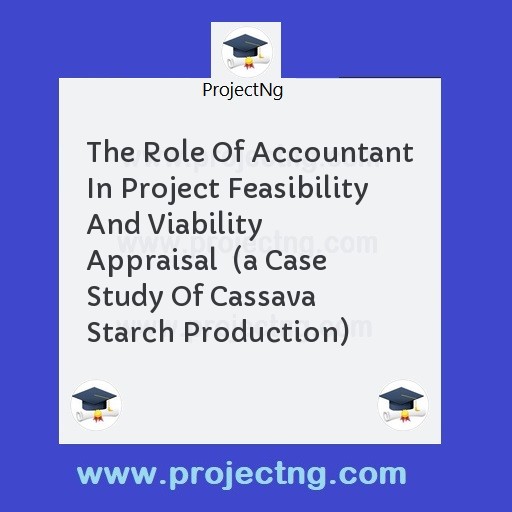The Role Of Accountant In Project Feasibility And Viability Appraisal (a Case Study Of Cassava Starch Production)
Accounting Project Topics
Get the Complete Project Materials Now! »
THE ROLE OF ACCOUNTANT IN PROJECT FEASIBILITY AND VIABILITY APPRAISAL
(A CASE STUDY OF CASSAVA STARCH PRODUCTION)
ABSTRACT
The entrepreneur must have a range outlook on the intended business investments, business investments, examine the alternative uses of capital and account for financial requirement and carry sensitivity and risk analysis.
This study promises an analysis and illustration of the principles of feasibility and viability appraisals and highlights the essence of the subject matter. It also brings into focus the accountants essential contributions, which have hitherto tended to be cost in wide diffusion
In view of the objective of the study, the literature review examines the views of various writers on the subject matter. Its emphasis is on meaning, importance and components of feasibility and viability studies historical perspective and the role of the accountant thereof.
Research design and methodology details the method used in carrying out the research for the project. It specifies the sources of data, target population, sampling method and also describes the research instruments and method of administration and analysis of data.
Data presentationa dn analysis presnts a afeasbility case study of hosuehold cassava – starch milling plant. It details the findings of the researcher regarding the project and examiones.
Specifically the marketing, technical economic and social factors involved
Financial analysis and evaluation provides an illustration of the role of the accountant in a practical project appraisal situation. It details the application of the data presented above in making relevant financial projections for 5 years.
Also a matching of the projected cost against the projected revenue is done.
In conclusion, this study centered on the role of an accountant in a project evaluation which has been demonstrated in this study by the viability appraisal of operating a starch milling plant
Table of contents
Title page
Approval
Dedication
Acknowledgement
Abstract
Table of content
CHAPTER ONE
1.0 Introduction
1.1 Background to the study
1.2 Statement of the problem
1.3 The objective of the study
1.4 Scope of the study
1.5 Research questions
1.6 Significance of the study
1.7 Definition of the terms used in the study
CHAPTER TWO
2.0 Literature review
2.1 Meaning and significance of feasibility and viability appraisal
2.2 Historical perspective
2.3 Basic distinction between feasibility and viability appraisal
2.4 The importance of feasibility and viability appraisal
2.5 Compared of feasibility and viability study
2.6 Roles of accountant in the formation and development of new enterprises
2.7 Feasibility and viability studies and accountant.
Chapter three
3.0 Research methodology
3.1 Research design
3.2 Population and sample size
3.3 Research instrument used
3.4 Design of interview guides
3.5 Method of data analysis
Chapter four
4.0 Data presentation
4.1 Data presentation and analysis of result
Chapter five
5.0 Summary of findings, recommendations and conclusion
5.1 Recommendations
5.2 Conclusions
References
Appendix I
CHAPTER ONE
1.0 INTRODUCTION
Almost daily, Nigeria Newspapers Larry prominent reports of new manufacturing ventures soon to be launched by individual or by local groups. Perhaps, tomorrow a state government will be telling us how college industries will stem the flow of youths from rural to urban areas. From the headlines alone Nigerians cannot escape the feeling that the rest of the 1990s holds great promise for unprecedented economic and social progress. But these expectations will be fulfilled only if most of the specific projects survive their early lives. Besides, not all those new projects will be completed. Some that get completed will not prove profitable and may soon close down. According to Nwoko (1988:34) summits that in simple terms one reason for which new projects may not be completed but have to be abandoned or profitable ventures may get choked up by controllable environmental factors and circumstance is that proper feasibility analysis was not conducted abinitio, before take –off of project.
According to Ume 91977:10).. stated that proposals schemes or projects for social, environmental and economic development demand feasibility and viability appraisal. In fact the two fundamental questions which feasibility and viability appraisal seek to answer are inevitable for prudent decision – making at all levels in the society.
The entrepreneur must have a long range outlook on the intended business investment, examine the alternative uses of capital and account for inflation in future value of cash flows, and forecast future events and financial requirements and carry sensitivity and risk analysis.
These are highly technical areas of knowledge that calls for expertise skills. Therefore this category of valuation (no doubt) holds out limitless opportunities and boundless scope for service and rewards for the accountants economists, valuers or appraisers.
This study provides an analysis and illustration of the principles of feasibility and viability appraisals and highlights the essence of the subject matter. If also brings into sharp focus the accountants essential contributions which have hitherto tended to be lost in wide diffusion
1.1 BACKGROUND OF THE STUDY
Be the First to Share On Social

Enjoying our content?
Don't miss out on new videos! Subscribe to our YouTube channel for more awesome content.
Subscribe Now!













